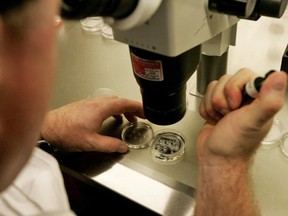Science
Scientists Transform Skin Cells into Fertilizable Eggs in Breakthrough

PARIS — A team of scientists announced on March 13, 2024, that they have successfully converted human skin cells into fertilizable eggs and fertilized them in the laboratory. This significant breakthrough could pave the way for infertile couples to conceive children using their own genetic material. While this innovative technology, known as in-vitro gametogenesis (IVG), is still years away from practical application, experts believe it could redefine the landscape of infertility treatment.
Paula Amato, a researcher at Oregon Health & Science University and co-author of the study, explained that this development could provide options for older women or those who lack viable eggs. “It also would allow same-sex couples to have a child genetically related to both partners,” she stated. The implications of this research directly address the challenges faced by the one in six people worldwide who experience infertility.
Breakthrough Technique and Results
The research, published in the journal Nature Communications, highlights a novel approach. Unlike previous studies primarily using animal DNA, this research directly employed human DNA. The scientists used a method called somatic cell nuclear transfer, which involves removing the nucleus from skin cells and transferring it into a donor egg devoid of its own nucleus, a process famously used to clone Dolly the sheep in 1996.
One of the challenges encountered was the difference in chromosome numbers; human skin cells contain 46 chromosomes while eggs typically contain only 23. The researchers developed a process named “mitomeiosis” to eliminate the excess chromosomes, effectively simulating natural cell division. They successfully created 82 developing eggs, known as oocytes, which were subsequently fertilized through in vitro fertilization (IVF).
After six days, approximately nine percent of the embryos reached a stage suitable for potential transfer to a uterus, although many exhibited abnormalities. The researchers acknowledged that while the nine percent success rate appears low, it is comparable to natural reproduction, where roughly one-third of embryos progress to the “blastocyst” stage necessary for implantation.
Future Implications and Ethical Considerations
Despite the promise of this research, Amato estimates that the technology is still at least a decade away from being widely accessible. “The biggest hurdle is trying to achieve genetically normal eggs with the correct number and complement of chromosomes,” she noted. The scientific community is keen to explore the potential of IVG further, with some researchers pursuing alternative methods that involve reprogramming skin cells into induced pluripotent stem cells, which can then be developed into eggs.
Ying Cheong, a reproductive medicine researcher at the University of Southampton, praised the advancement, stating that it represents an exciting step forward. “For the first time, scientists have shown that DNA from ordinary body cells can be placed into an egg, activated, and made to halve its chromosomes,” she commented. This research could significantly enhance the understanding of infertility and miscarriage, potentially leading to new options for individuals lacking reproductive capabilities.
The researchers adhered to existing ethical guidelines regarding embryo use in the United States, ensuring that their work aligns with established standards of practice.
As this groundbreaking research progresses, it holds the potential to transform the future of reproductive medicine and offer hope to those facing infertility challenges. While the journey toward practical applications remains long, the initial findings are a promising step toward expanding reproductive options for many individuals and couples worldwide.
-

 Lifestyle1 month ago
Lifestyle1 month agoWinnipeg Celebrates Culinary Creativity During Le Burger Week 2025
-

 Health2 months ago
Health2 months agoMontreal’s Groupe Marcelle Leads Canadian Cosmetic Industry Growth
-

 Science2 months ago
Science2 months agoMicrosoft Confirms U.S. Law Overrules Canadian Data Sovereignty
-

 Education2 months ago
Education2 months agoRed River College Launches New Programs to Address Industry Needs
-

 Technology2 months ago
Technology2 months agoDragon Ball: Sparking! Zero Launching on Switch and Switch 2 This November
-

 Science2 months ago
Science2 months agoTech Innovator Amandipp Singh Transforms Hiring for Disabled
-

 Technology2 months ago
Technology2 months agoGoogle Pixel 10 Pro Fold Specs Unveiled Ahead of Launch
-

 Science2 months ago
Science2 months agoChina’s Wukong Spacesuit Sets New Standard for AI in Space
-

 Technology2 months ago
Technology2 months agoWorld of Warcraft Players Buzz Over 19-Quest Bee Challenge
-

 Science2 months ago
Science2 months agoXi Labs Innovates with New AI Operating System Set for 2025 Launch
-

 Business2 months ago
Business2 months agoDawson City Residents Rally Around Buy Canadian Movement
-

 Business2 months ago
Business2 months agoNew Estimates Reveal ChatGPT-5 Energy Use Could Soar
-

 Technology2 months ago
Technology2 months agoInnovative 140W GaN Travel Adapter Combines Power and Convenience
-

 Technology2 months ago
Technology2 months agoFuture Entertainment Launches DDoD with Gameplay Trailer Showcase
-

 Technology2 months ago
Technology2 months agoGlobal Launch of Ragnarok M: Classic Set for September 3, 2025
-

 Education2 months ago
Education2 months agoAlberta Teachers’ Strike: Potential Impacts on Students and Families
-

 Technology2 months ago
Technology2 months agoNew IDR01 Smart Ring Offers Advanced Sports Tracking for $169
-

 Technology2 months ago
Technology2 months agoArsanesia Unveils Smith’s Chronicles with Steam Page and Trailer
-

 Technology2 months ago
Technology2 months agoHumanoid Robots Compete in Hilarious Debut Games in Beijing
-

 Science2 months ago
Science2 months agoNew Precision Approach to Treating Depression Tailors Care to Patients
-

 Health2 months ago
Health2 months agoGiant Boba and Unique Treats Take Center Stage at Ottawa’s Newest Bubble Tea Shop
-

 Technology2 months ago
Technology2 months agoQuoted Tech Launches Back-to-School Discounts on PCs
-

 Business2 months ago
Business2 months agoBNA Brewing to Open New Bowling Alley in Downtown Penticton
-

 Technology2 months ago
Technology2 months agoDiscover the Relaxing Charm of Tiny Bookshop: A Cozy Gaming Escape










